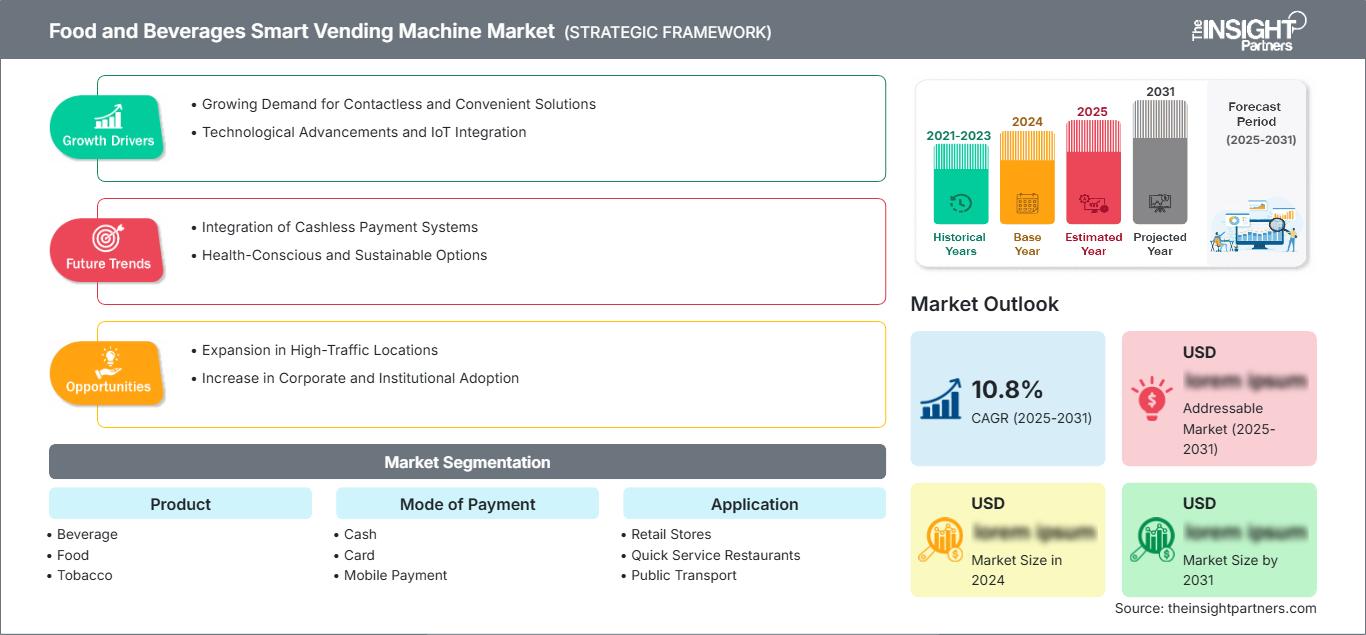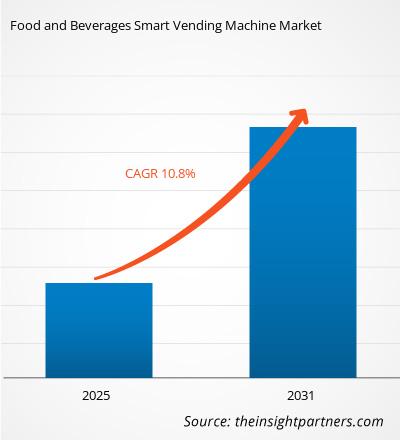Le marché des distributeurs automatiques intelligents pour aliments et boissons devrait enregistrer un TCAC de 10,8 % entre 2025 et 2031, avec une taille de marché passant de XX millions de dollars américains en 2024 à XX millions de dollars américains d'ici 2031.
Le rapport est segmenté par produit (boissons, aliments, tabac, autres), mode de paiement (espèces, carte (débit/crédit), paiement mobile) et application (magasins de détail, restauration rapide, transports publics, centres d'affaires, autres). L'analyse mondiale est ensuite ventilée au niveau régional et par principaux pays. Le rapport présente la valeur en USD pour l'analyse et les segments ci-dessus.
Objectif du rapport
Le rapport sur le marché des distributeurs automatiques intelligents pour aliments et boissons de The Insight Partners vise à décrire le paysage actuel et la croissance future, les principaux facteurs moteurs, les défis et les opportunités. Cela fournira des informations à diverses parties prenantes commerciales, telles que :
- Fournisseurs/fabricants de technologie : pour comprendre l’évolution de la dynamique du marché et connaître les opportunités de croissance potentielles, leur permettant de prendre des décisions stratégiques éclairées.
- Investisseurs : pour effectuer une analyse complète des tendances concernant le taux de croissance du marché, les projections financières du marché et les opportunités qui existent tout au long de la chaîne de valeur.
- Organismes de réglementation : pour réglementer les politiques et surveiller les activités du marché dans le but de minimiser les abus, de préserver la confiance des investisseurs et de maintenir l’intégrité et la stabilité du marché.
Segmentation du marché des distributeurs automatiques intelligents pour l'alimentation et les boissons Produit
- Boisson
- Alimentation
- Tabac
- Autres
Mode de paiement
- Espèces
- Carte
- Paiement mobile
Application
- Magasins de détail
- Restaurants à service rapide
- Transports en commun
- Centres d'affaires
- Autres
Géographie
- Amérique du Nord
- Europe
- Asie-Pacifique
- Amérique du Sud et centrale
- Moyen-Orient et Afrique
Vous bénéficierez d’une personnalisation sur n’importe quel rapport - gratuitement - y compris des parties de ce rapport, ou une analyse au niveau du pays, un pack de données Excel, ainsi que de profiter d’offres exceptionnelles et de réductions pour les start-ups et les universités
Marché des distributeurs automatiques intelligents pour aliments et boissons: Perspectives stratégiques

- Obtenez les principales tendances clés du marché de ce rapport.Cet échantillon GRATUIT comprendra une analyse de données, allant des tendances du marché aux estimations et prévisions.
Facteurs de croissance du marché des distributeurs automatiques intelligents pour l'alimentation et les boissons
- Demande croissante de solutions sans contact et pratiques : La demande croissante de solutions sans contact et en libre-service est un moteur important du marché des distributeurs automatiques intelligents pour l'alimentation et les boissons. Ces distributeurs, équipés d'interfaces numériques et d'options de paiement sans espèces, offrent aux consommateurs un moyen pratique et hygiénique d'acheter de la nourriture et des boissons, en particulier après la pandémie. Alors que les consommateurs privilégient la sécurité et la commodité, le marché des distributeurs automatiques intelligents continue de croître.
- Progrès technologiques et intégration de l'IoT : L'intégration de la technologie de l'Internet des objets (IoT) dans les distributeurs automatiques intelligents stimule leur adoption. Grâce à l'IoT, ces machines peuvent fournir des données en temps réel sur les stocks, suivre les ventes et envoyer des alertes pour le réapprovisionnement, la maintenance ou le contrôle de la température. Ces avancées améliorent l'efficacité opérationnelle des distributeurs automatiques, ce qui accroît la fiabilité et la satisfaction des clients, stimulant ainsi la croissance du marché.
Tendances futures du marché des distributeurs automatiques intelligents pour l'alimentation et les boissons
- Intégration des systèmes de paiement sans espèces : l'une des principales tendances du marché des distributeurs automatiques intelligents pour l'alimentation et les boissons est l'intégration croissante des systèmes de paiement sans espèces, tels que les portefeuilles mobiles, les cartes de crédit et la lecture de codes QR. Cette tendance est motivée par l'adoption croissante des méthodes de paiement numériques et la demande de transactions plus rapides, plus sûres et plus pratiques. Les systèmes sans espèces réduisent également le risque de fraude et améliorent l'efficacité des transactions, ce qui en fait une fonctionnalité standard des distributeurs automatiques intelligents.
- Options saines et durables : les consommateurs recherchent de plus en plus d'options plus saines et plus durables en matière d'alimentation et de boissons, et cette tendance se reflète sur le marché des distributeurs automatiques intelligents. Les distributeurs automatiques sont équipés d'options telles que des collations biologiques, des salades fraîches, des boissons hypocaloriques et des emballages écologiques. La sensibilisation croissante à la santé et au développement durable incite les exploitants de distributeurs automatiques à actualiser leurs offres, en s'alignant sur les préférences des consommateurs pour des choix nutritifs et respectueux de l'environnement.
Opportunités de marché des distributeurs automatiques intelligents pour l'alimentation et les boissons
- Expansion dans les lieux à fort trafic : les distributeurs automatiques intelligents offrent une opportunité de croissance significative dans les lieux à fort trafic tels que les aéroports, les centres commerciaux, les hôpitaux et les immeubles de bureaux. Ces zones présentent une large base de consommateurs, idéale pour offrir une grande variété d'options de nourriture et de boissons grâce à des distributeurs automatiques pratiques, disponibles 24 h/24 et 7 j/7. La demande croissante de solutions alimentaires rapides et à emporter dans ces lieux offre une excellente opportunité de déploiement de distributeurs automatiques intelligents.
- Augmentation de l'adoption par les entreprises et les institutions : de nombreuses entreprises et établissements d'enseignement investissent dans des distributeurs automatiques intelligents pour offrir à leurs employés et aux étudiants des options de nourriture et de boissons plus saines, tout en améliorant la commodité. Les distributeurs automatiques intelligents des entreprises, des universités et des institutions gouvernementales peuvent être équipés de fonctionnalités personnalisées et d'options de produits plus sains, ce qui en fait une alternative attrayante pour ces secteurs. Cet intérêt croissant offre aux fabricants l'opportunité de cibler les clients institutionnels et les entreprises.
Aperçu régional du marché des distributeurs automatiques intelligents pour aliments et boissons
Les tendances régionales et les facteurs influençant le marché des distributeurs automatiques intelligents pour l'alimentation et les boissons tout au long de la période de prévision ont été analysés en détail par les analystes de The Insight Partners. Cette section aborde également les segments et la géographie du marché des distributeurs automatiques intelligents pour l'alimentation et les boissons en Amérique du Nord, en Europe, en Asie-Pacifique, au Moyen-Orient et en Afrique, ainsi qu'en Amérique du Sud et en Amérique centrale.
Portée du rapport sur le marché des distributeurs automatiques intelligents pour aliments et boissons
Attribut de rapport Détails Taille du marché en 2024 US$ XX million Taille du marché par 2031 US$ XX Million TCAC mondial (2025 - 2031) 10.8% Données historiques 2021-2023 Période de prévision 2025-2031 Segments couverts By Produit - boisson
- nourriture
- tabac
- autres
- espèces
- carte
- paiement mobile
- magasins de détail
- restaurants à service rapide
- transports en commun
- centres d'affaires
- autres
- Amérique du Nord
- Europe
- Asie-Pacifique
- Amérique du Sud et centrale
- Moyen-Orient et Afrique
Régions et pays couverts Amérique du Nord - États-Unis
- Canada
- Mexique
- Royaume-Uni
- Allemagne
- France
- Russie
- Italie
- reste de l'Europe
- Chine
- Inde
- Japon
- Australie
- reste de l'Asie-Pacifique
- Brésil
- Argentine
- reste de l'Amérique du Sud et centrale
- Afrique du Sud
- Arabie saoudite
- Émirats arabes unis
- reste du Moyen-Orient et de l'Afrique
Leaders du marché et profils d'entreprises clés - Azkoyen Group
- Bianchi Vending
- Crane Merchandising Systems
- Evoca Group
- FAS International
- Fuji Electric Co., Ltd.
- Royal Vendors, Inc.
- Seaga
- Sielaff GmbH and Co. KG Automatenbau
Densité des acteurs du marché des distributeurs automatiques intelligents pour aliments et boissons : comprendre son impact sur la dynamique commerciale
Le marché des distributeurs automatiques intelligents pour l'alimentation et les boissons connaît une croissance rapide, portée par une demande croissante des utilisateurs finaux, due à des facteurs tels que l'évolution des préférences des consommateurs, les avancées technologiques et une meilleure connaissance des avantages du produit. Face à cette demande croissante, les entreprises élargissent leur offre, innovent pour répondre aux besoins des consommateurs et capitalisent sur les nouvelles tendances, ce qui alimente la croissance du marché.

- Obtenez le Marché des distributeurs automatiques intelligents pour aliments et boissons Aperçu des principaux acteurs clés
- Analyse historique (2 ans), année de base, prévision (7 ans) avec TCAC
- Analyse PEST et SWOT
- Taille du marché Valeur / Volume - Mondial, Régional, Pays
- Industrie et paysage concurrentiel
- Ensemble de données Excel
Rapports récents
Rapports connexes
Marché de la surveillance de l'état des machines Marché de la vision industrielle Marché de l'apprentissage automatique Marché de la surveillance de l'état des machines Marché des machines de remplissage de liquides Marché des solutions de protection des machines Marché des tours Marché des machines-outils Marché des machines de séchage sous vide pour aliments Marché des machines de soudage par friction Marché des friteuses industrielles Marché des machines à café entièrement automatiques Marché des machines pour laminoirs à feuilles Marché des machines de formage, de remplissage et de scellage Marché des machines de brassage de bière à domicile Marché des machines de scellage par induction Marché des machines d'implantation ionique Marché des distributeurs automatiques industriels Marché des machines à tricoter industrielles Marché des machines à plastifier industriellesTémoignages
Raison d'acheter
- Prise de décision éclairée
- Compréhension de la dynamique du marché
- Analyse concurrentielle
- Connaissances clients
- Prévisions de marché
- Atténuation des risques
- Planification stratégique
- Justification des investissements
- Identification des marchés émergents
- Amélioration des stratégies marketing
- Amélioration de l'efficacité opérationnelle
- Alignement sur les tendances réglementaires




















 Obtenez un échantillon gratuit pour - Marché des distributeurs automatiques intelligents pour aliments et boissons
Obtenez un échantillon gratuit pour - Marché des distributeurs automatiques intelligents pour aliments et boissons